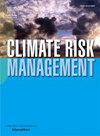Disaster vulnerability hotspots in the Portland metro-region: Converging indices for equitable resilience
IF 5
2区 环境科学与生态学
Q1 ENVIRONMENTAL SCIENCES
引用次数: 0
Abstract
As climate-related extreme events intensify across the globe, governments, practitioners, and communities have focused on reducing vulnerability and building resilience. However, debates persist about the validity, differences, and similarities between social vulnerability and resilience indices. This study combines the Social Vulnerability Index (SoVI) (26 indicators) and the Baseline Resilience Indicators for Communities (BRIC) (52 indicators) to assess the Portland Metro region using ACS (2016–2020) and 2020 Census data. Through hotspot analysis, Pearson’s correlation, and linear regression, we identify key drivers as well as areas of convergence and divergence between the two indices. Results show a strong overlap between SoVI and BRIC, with distinct drivers across counties and census tracts. High SoVI/low BRIC hotspots were found in Clackamas and Multnomah counties. In Clackamas, vulnerability was due to limited hospital access, weak infrastructure and institutions, mobile homes, and inadequate community resources. In Multnomah, poverty, low educational attainment, and single-parent households were the primary drivers of vulnerability. While Clackamas had stronger environmental resilience, Multnomah showed higher resilience than Washington County due to better transportation, institutions, and community capital. Having a high proportion of migrant populations, institutionalized residents, and mobile homes reduced resilience in Washington County. These findings support the combined use of SoVI-BRIC indices for targeted resilience planning and equitable resource allocation for infrastructure development, environmental protection, social programs, and emergency preparedness across multiple scales.
波特兰都市圈的灾害脆弱性热点:公平复原力的趋同指数
随着与气候相关的极端事件在全球范围内不断加剧,各国政府、从业者和社区都将重点放在降低脆弱性和增强抵御能力上。然而,关于社会脆弱性和恢复力指数之间的有效性、差异性和相似性的争论仍然存在。本研究结合了社会脆弱性指数(SoVI)(26个指标)和社区基线弹性指标(BRIC)(52个指标),使用ACS(2016-2020)和2020年人口普查数据对波特兰地铁地区进行了评估。通过热点分析、Pearson’s correlation和线性回归,我们发现了两个指数之间的关键驱动因素以及趋同和分化区域。结果显示,SoVI和金砖四国之间有很强的重叠,不同国家和人口普查区的驱动因素不同。高SoVI/低金砖国家热点地区位于克拉克马斯县和摩特诺玛县。在克拉卡马斯,脆弱性是由于医院服务有限、基础设施和机构薄弱、流动住房和社区资源不足。在摩特诺玛,贫困、受教育程度低和单亲家庭是造成脆弱性的主要因素。克拉克马斯县具有更强的环境恢复力,而摩特诺玛县由于交通、制度和社区资本的改善而比华盛顿县表现出更高的恢复力。高比例的移民人口、机构居民和流动房屋降低了华盛顿县的恢复能力。这些发现支持将SoVI-BRIC指数结合使用,在多个尺度上为基础设施发展、环境保护、社会项目和应急准备进行有针对性的复原力规划和公平的资源分配。
本文章由计算机程序翻译,如有差异,请以英文原文为准。
求助全文
约1分钟内获得全文
求助全文
来源期刊

Climate Risk Management
Earth and Planetary Sciences-Atmospheric Science
CiteScore
8.20
自引率
4.50%
发文量
76
审稿时长
30 weeks
期刊介绍:
Climate Risk Management publishes original scientific contributions, state-of-the-art reviews and reports of practical experience on the use of knowledge and information regarding the consequences of climate variability and climate change in decision and policy making on climate change responses from the near- to long-term.
The concept of climate risk management refers to activities and methods that are used by individuals, organizations, and institutions to facilitate climate-resilient decision-making. Its objective is to promote sustainable development by maximizing the beneficial impacts of climate change responses and minimizing negative impacts across the full spectrum of geographies and sectors that are potentially affected by the changing climate.
 求助内容:
求助内容: 应助结果提醒方式:
应助结果提醒方式:


